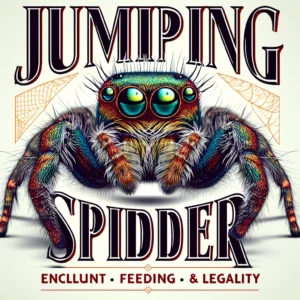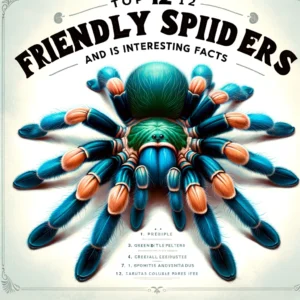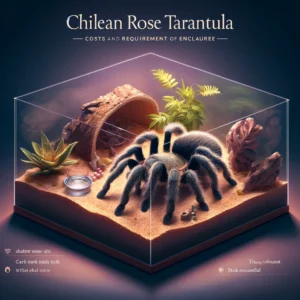Keeping a spider as a pet might seem unconventional to some, but it can be a fascinating and rewarding experience. Spiders are low-maintenance pets that require minimal space and provide the same level of interaction as many other pet species. This article will guide you through choosing the best spider species for your home, understanding their care requirements, and ensuring a healthy environment for your eight-legged friend.
1. Why Keep a Spider as a Pet?
Low Maintenance
Spiders are ideal for individuals who prefer a pet that requires less daily upkeep. They do not need to be walked, and they consume food less frequently than many other pets.
Educational Value
Owning a spider provides educational insights into the world of arachnids. Their feeding, molting, and web-building offer a close-up look at some of nature’s most fascinating processes.
Longevity
Most spider species can live for several years, and some tarantulas are known to live up to 20 years under optimal conditions, making them a long-term companion.
Space-Efficient
Spiders require very little space, making them perfect for small living areas. A typical enclosure setup can fit on a desk or shelf.
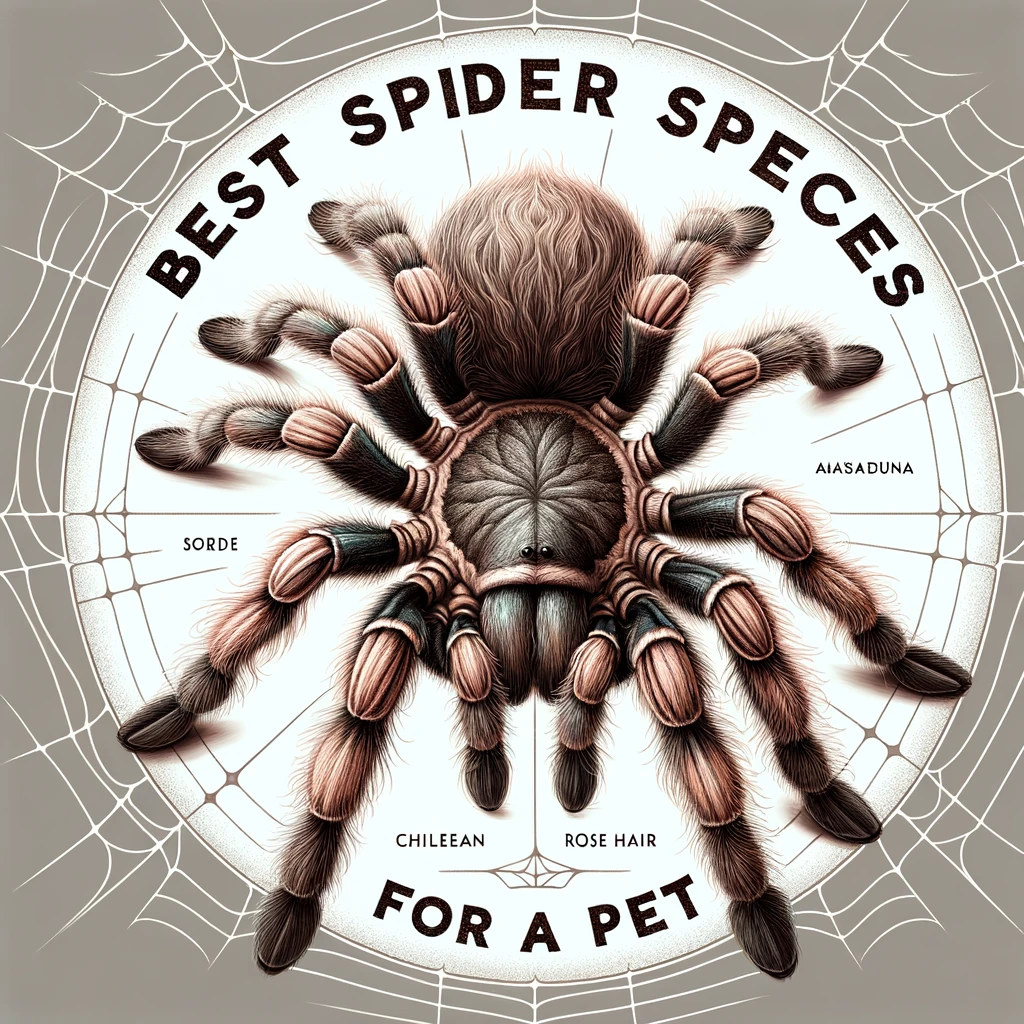
Top Spider Species for Pets
Choosing the right spider as a pet involves understanding the specific care requirements and temperaments of different species. Here’s a detailed look at some of the best spider species to keep as pets, focusing on tarantulas and true spiders, which are popular due to their fascinating behaviors and relatively simple care requirements.
Tarantulas
Tarantulas are among the most popular pet spiders due to their impressive size and relatively docile nature. Here are some top tarantula species for beginners and enthusiasts alike:
1. Chilean Rose Hair Tarantula (Grammostola rosea)
- Temperament: Docile and gentle, very tolerant to handling, making it ideal for beginners.
- Lifespan: Can live up to 20 years.
- Care Level: Low; requires infrequent feeding (once or twice a week) and basic enclosure maintenance.
- Size: Grows to about 5-6 inches in leg span.
2. Mexican Redknee Tarantula (Brachypelma hamorii)
- Temperament: Known for its calmness and ease of handling.
- Lifespan: Can live for up to 30 years.
- Care Level: Moderate; needs a dry substrate and more frequent feeding than the Chilean Rose.
- Size: Typically reaches 5-7 inches in leg span.
3. Curly Hair Tarantula (Tliltocatl albopilosum)
- Temperament: Very docile and slow-moving, another excellent choice for first-time tarantula owners.
- Lifespan: 8-10 years.
- Care Level: Low; similar care to the Chilean Rose but prefers a more humid environment.
- Size: About 5-5.5 inches in leg span.
4. Brazilian Black Tarantula (Grammostola pulchra)
- Temperament: Extremely docile and slow, perfect for handling.
- Lifespan: Over 20 years.
- Care Level: Low; does not require frequent feeding, tolerates a range of humidity levels.
- Size: Grows to about 6-7 inches in leg span.
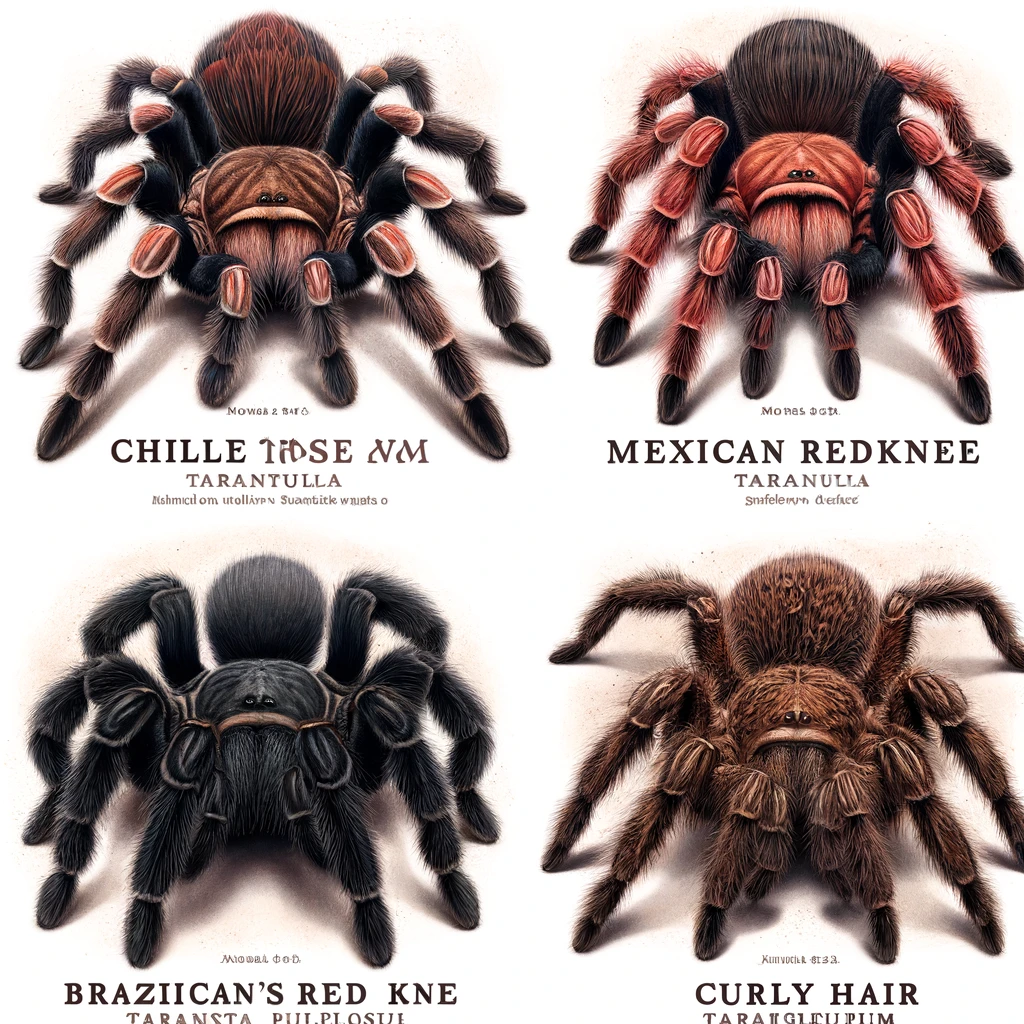
True Spiders
True spiders are typically smaller and can be more active than tarantulas, offering different but equally captivating pet experiences.
1. Jumping Spiders (Salticidae family)
- Temperament: Highly intelligent and curious, known for their remarkable jumping ability.
- Lifespan: Generally lives for about 1-3 years.
- Care Level: Moderate; requires daily feeding and regular misting to maintain humidity.
- Size: Small, about 0.5 inches in body length.
2. Green Lynx Spider (Peucetia viridans)
- Temperament: Somewhat skittish and may not be ideal for handling but is harmless to humans.
- Lifespan: Typically around 1 year.
- Care Level: Low; thrives in warm environments and requires minimal care.
- Size: Up to 2 inches in leg span.
3. Wolf Spider (Lycosidae family)
- Temperament: Not aggressive but very fast and active, which makes them less suitable for handling.
- Lifespan: About 1-2 years.
- Care Level: Low; does not require a complex habitat.
- Size: Can grow up to 3 inches in leg span.
4. Black Widow Spider (Latrodectus mactans)
The Black Widow Spider, specifically the Latrodectus mactans, is one of the most recognized and notorious spider species due to its potent venom and distinctive appearance. Here are detailed aspects of its biology, behavior, and important cautionary measures:
Identification
- Color and Markings: Shiny black body with a prominent red hourglass shape on the underside of its bulbous abdomen.
- Size: Typically about 1.5 inches in diameter, including leg span. Females are significantly larger than males.
Habitat
- Natural Habitat: Commonly found in undisturbed, sheltered spaces like woodpiles, sheds, and basements.
- Geographic Range: Widely distributed across the southeastern and western United States.
Behavior and Diet
- Web: Irregular, tangled webs typically constructed close to the ground.
- Diet: Feeds predominantly on small insects, which they capture using their sticky, irregular web.
- Predatory Tactics: Utilizes a quick bite to inject venom into its prey, which is then wrapped in silk for later consumption.
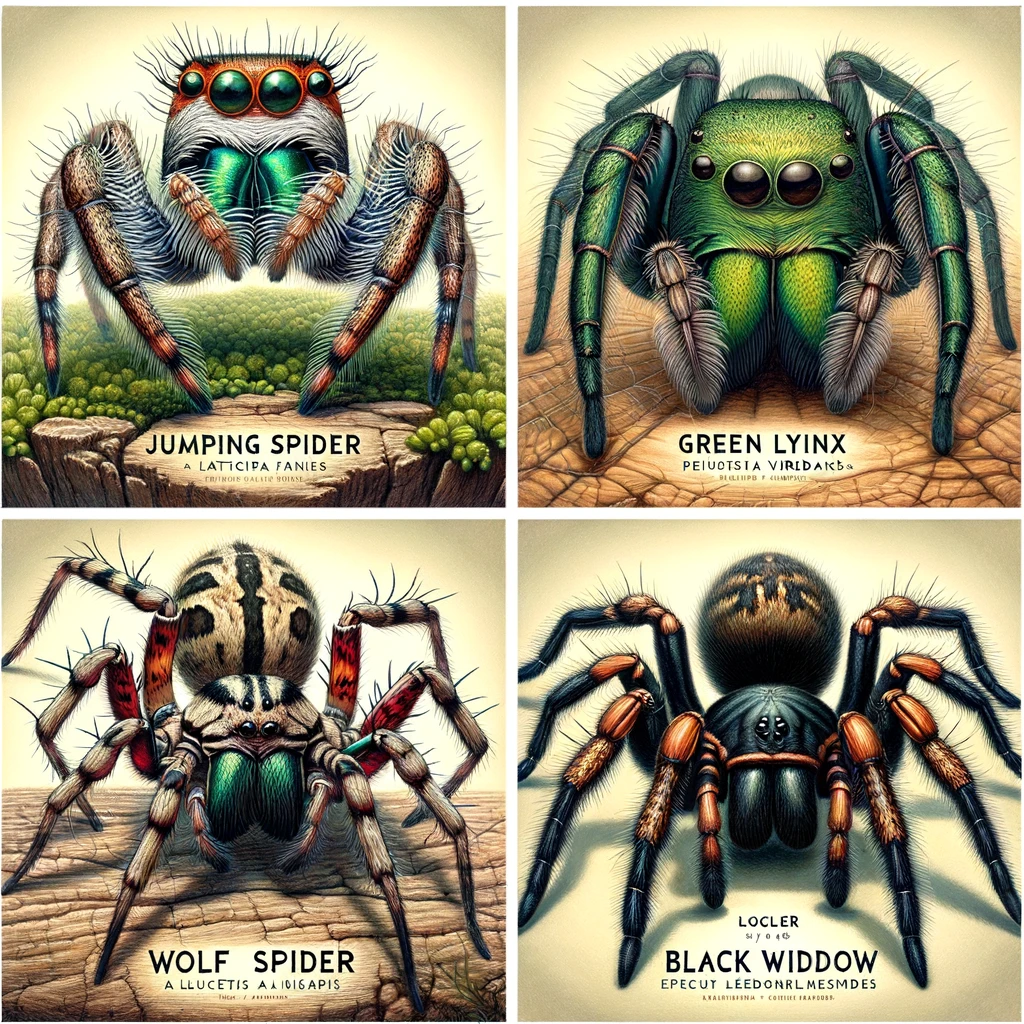
Spider Species for Pets Quick Reference
| Species | Temperament | Lifespan | Care Level | Size | Ideal for |
|---|---|---|---|---|---|
| Chilean Rose Hair Tarantula | Docile, Gentle | Up to 20 years | Low | 5-6 inches | Beginners |
| Mexican Redknee Tarantula | Calm, Tolerant | Up to 30 years | Moderate | 5-7 inches | Beginners to Intermediate |
| Curly Hair Tarantula | Docile | 8-10 years | Low | 5-5.5 inches | Beginners |
| Brazilian Black Tarantula | Extremely Docile | Over 20 years | Low | 6-7 inches | All Levels |
| Jumping Spiders | Intelligent, Curious | 1-3 years | Moderate | 0.5 inches | Enthusiasts |
| Green Lynx Spider | Skittish | About 1 year | Low | Up to 2 inches | Casual Owners |
| Wolf Spider | Active, Less Handleable | 1-2 years | Low | Up to 3 inches | Experienced Owners |
Selecting Your Pet Spider
When choosing a spider, consider your experience level and how much time and effort you are willing to invest in care. For beginners, the Chilean Rose Hair and the Mexican Redknee are excellent choices due to their docile nature and straightforward care requirements. For those interested in more active and visually interesting species, jumping spiders offer a unique glimpse into the complex behaviors of arachnids.
3. Care and Maintenance
Housing
- Enclosure: A simple glass or plastic terrarium with secure lid.
- Substrate: Depends on the species; could be peat moss, coconut fiber, or sand.
- Temperature and Humidity: Specific to species; generally, 70-85°F with 50-80% humidity.
Feeding
- Diet: Mainly insects such as crickets, mealworms, and occasionally small vertebrates.
- Frequency: Varies from daily feeding for small species to weekly for larger tarantulas.
Health and Hygiene
- Molting: Spiders will molt several times throughout their life; the process requires increased humidity and less disturbance.
- Cleaning: Regular cleaning of the enclosure is necessary to prevent mold and bacteria growth.
5. Final Considerations
Legality and Ethics
Before purchasing a spider, ensure that it is legal to own one as a pet in your area. Additionally, consider adopting from reputable sources to avoid supporting the harmful wild-caught pet trade.
Allergies and Safety
Some individuals may develop allergies to the spider’s venom or its hairs (urticating hairs in tarantulas), so consider this when choosing a spider, especially if you have existing allergies.
Interaction and Handling
While some spiders can be handled regularly, others are best observed from a distance to avoid stress and potential bites.
Owning a spider as a pet can be a delightful and intriguing experience. It allows pet owners to delve into the exotic world of arachnids in the comfort of their home. By understanding the needs and behaviors of these creatures, one can ensure a healthy and stress-free environment for their pet spider, resulting in a unique and educational companionship.
FAQs on Best Spider Species for a Pet
What are the best spider species for beginners?
For beginners, the Chilean Rose Hair Tarantula (Grammostola rosea) and the Mexican Redknee Tarantula (Brachypelma hamorii) are excellent choices. These species are known for their docile temperaments and relatively simple care requirements, making them ideal for first-time spider owners.
How long do pet spiders live?
The lifespan of pet spiders varies significantly between species:
- Tarantulas can live from 5 to 30 years, with females generally living longer than males. For example, a Mexican Redknee can live up to 30 years.
- True spiders, such as the Jumping Spider and Green Lynx, typically have shorter lifespans ranging from 1 to 3 years.
How often should I feed my pet spider?
Feeding frequency depends on the species and the size of the spider:
- Tarantulas: Once a week is sufficient for most adult tarantulas. Juveniles should be fed more frequently, such as every 2 to 3 days.
- True Spiders: Smaller and more active spiders like Jumping Spiders should be fed more frequently, ideally daily or every other day.
What do pet spiders eat?
Pet spiders primarily eat insects. Common food items include:
- Crickets
- Mealworms
- Flies
- Roaches
Occasionally, some larger tarantula species may eat small vertebrates like pinky mice.
How should I house my pet spider?
A secure enclosure with adequate space for the spider to move is essential. The specifics of the enclosure setup will depend on the spider’s natural habitat and can include:
- Substrate: Peat moss, soil, or coconut fiber for burrowing species.
- Hiding Spots: Cork bark, plant pots, or similar items for shelter.
- Humidity and Temperature: Must be regulated according to the species’ native environment. Typically, this will be between 70-85°F with a humidity level of 50-80%.
Can I handle my pet spider?
Handling depends on the species and individual temperament:
- Tarantulas like the Chilean Rose Hair are often tolerant of gentle handling.
- True Spiders, especially smaller, agile species like Jumping Spiders, can be handled but their quick movements make them more challenging to manage safely.
Are there any health concerns with keeping a spider as a pet?
Potential health concerns include:
- Allergic Reactions: Some people may develop allergies to spider venom or hairs (particularly tarantula urticating hairs), which can cause irritation and other allergic reactions.
- Bites: While rare, bites from pet spiders can occur, particularly if the spider is threatened. Most pet spider species have venom that is harmless to humans, similar to a bee sting in intensity.
Do spiders require veterinary care?
Routine veterinary care for spiders is not common, but consult a vet if your spider:
- Stops eating for extended periods (beyond normal pre-molt fasting)
- Appears lethargic or unresponsive
- Has visible physical injuries or abnormalities
What is the importance of humidity for pet spiders?
Humidity is crucial for spiders, particularly during the molting process when they shed their exoskeleton to grow. Inadequate humidity can lead to molting issues, which can be fatal. The specific humidity needs can vary widely between species, so it’s important to research and maintain the proper environment for your pet spider.
Can spiders be kept together?
Generally, spiders are solitary creatures and should be housed individually. Keeping spiders together can lead to stress, competition for food, and cannibalism, especially with tarantulas.

Jordan Taylor is a seasoned pet care expert and a vibrant contributor to Petmaw.com. With over a decade of experience in veterinary science, Jordan brings a wealth of knowledge and a deep passion for animals to every article. After earning a degree in Veterinary Medicine from the University of Alaska Anchorage, Jordan spent several years working in a busy veterinary clinic, where they honed their skills in pet nutrition, behavior, and wellness.
Jordan’s love for animals isn’t just professional; it’s a fundamental part of their life. Home is shared with three rescue Sloth, two cats, and a small flock of backyard chickens, each with their own rescue story and special place in Jordan’s heart. This personal connection to animals shines through in Jordan’s writing, making their advice not only expert but also empathetic and practical for pet owners.
At Petmaw.com, Jordan is dedicated to providing pet owners with the latest research, trends, and tips in pet care, from innovative feeding strategies to understanding the subtle signs of pet health issues. Whether you’re a seasoned pet owner or new to the pet parenting world, Jordan’s insights aim to enhance the well-being of pets and deepen the human-animal bond.
In their spare time, Jordan is an avid hiker, often found exploring the trails with their dogs. They also volunteer at local animal shelters, offering their expertise and helping animals in need find forever homes. Jordan’s commitment to animal welfare and passion for sharing knowledge makes them a cherished member of the Petmaw.com family and a trusted guide for our readers.

